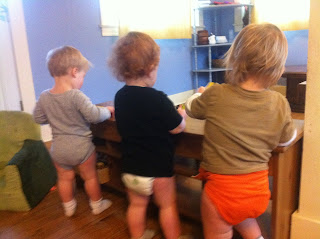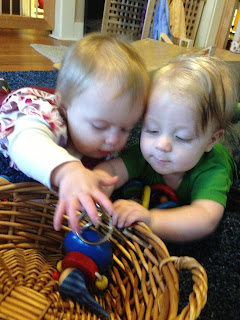Recently we did a parent workshop on limit setting with our infant and wobbler classroom parents. In preparation for the work shop, we (Melinda and Briana) discussed some basic questions: What are limits and why do we use them? What do they provide for us and the child? How do we come up with limits? How do the limits that we set empower children and meet the needs of our family? In the end, we decided to focus on the process of limit setting.
For us, the process is three steps:
1. Setting the Limit
2. The Zen State
3. Following Through and Following Up
Throughout the workshop itself we built on the process, discussed scenarios, and had some amazing dialogue with our amazing parents. Below is a deeper look into some of the highlights of our workshop and where the conversation went.
Setting the Limit
Coming up with the limits...
- An evolution of what's
important to/defines your family and the culture of your family.
- Each child (and adult!) have their
own unique needs so limits might vary.
- Setting limits in
infancy/toddlerhood helps set up expectations. It builds the
process/culture of your family/school/community/etc.
- Offer choices to your child when you
can! Giving them ownership over the limit helps.
Anticipation is Participation...
- Prepare
both your child and yourself in advance when possible. It's hard but
gives time for processing. How far in advance varies with each
child's needs and abilities.
- Be direct and use
language that is appropriate for your child's ability. Key phrases
that they can recognize like “Kids who A, get to B” can be
great for consistency.
 Examples!
Examples!
To
a preschooler who has hit their sister after she took a toy: “Wait!
I won't let you hit her. (Pause) The thing about our family is
that we keep everyone safe. I can tell you feel frustrated about
your sister taking that toy. What might work instead?”
To
a young infant who wants to crawl off their mat at naptime: “It's
time to sleep. I can see that you want to get off your mat. I will
help you to rest.”
To
a toddler who won't brush their teeth: “Kids
who brush their teeth get to read books. (pause) The thing I know
about you is that you really love getting to rinse!”
The
key ingredients of a good limit? Clear. Honest. Age appropriate.
Helps the child feel seen and acknowledged.
 The
Zen State
The
Zen State
Supporting
divergent thinking and advocacy...
-
Your child might test your limit! They are working to figure out
what works/doesn't work.
- Allow your child time to process the limit and decide how they want
to react.
- Let your child own their emotions-
this supports advocacy! Remaining calm helps reduce shame and builds
your child's emotional intelligence.
Narrate, Narrate, Narrate...
- Talking
through what is happening helps calm both you and your child.
Acknowledging the situation and how you both are feeling maintains
the zen state and builds coping skills.
- Narration can be
like an unstructured mantra that gives you a chance to be fully
present, observe without shame, and take a breath.
- While narrating,
your tone is just as important, if not more, as the words you are
saying.
 Examples!
Examples!
To
the preschooler: After
giving them a chance to come up with their own plan, offer help as
needed or talk through their chosen path. Remember to allow them to
try out their own plans, even if you are sure they won't work.
To
the young infant: Breathe
deeply and force your adult thoughts out of your head. Focus on
the child and being the calm you want them to be.
To
the toddler: Remain
present but give them a chance to initiate the
next step. “When you're ready you can turn on the
water. I can help you put the toothpaste on your blue toothbrush if
you want!”
The
key to the zen state? Narrating and remaining calm helps you as much
as them!
 Following
Through
Following
Through
Hear them. See
them. Notice them.
-
Acknowledge your child's needs and emotions. “It didn't work to
take the toy from her. She's holding on to it tightly. You really
wanted it! That's really frustrating.”
- Be available for comfort but allow your child space to work through
it on their own.
- Keep the narration going even as you follow through (whether it
worked or not). For example, “You remembered that kids who brush
their teeth get to read books before bed! Which book will you
choose?”
- It's OK to take space!! You may need a minute to breathe before you
can be calm and present with your child. If so, then do so! Take a
sip of coffee, find a moment to breathe, take some space in another
room. Taking care of yourself is essential.
 Planning for
next time...
Planning for
next time...
- At
any age, you can plan for next time. Talk aloud with your child or
think to yourself about what worked/didn't work. What could go
differently next time? How can you set up yourself and your child
for success? Preschoolers can often do this on their own.
- This may mean re-evaulating the limit itself. Was the limit you
chose appropriate for your child, your family yourself, and the
situation? Was it communicated clearly? Is it flexible?
 Examples!
Examples!
To
the preschooler: “Look!
It worked. First you tried taking it from her but she held on
tightly. Next you asked if you could use it when she was done. Now
she's finished and you get a turn. That worked!”
To
the infant: (Before
the next nap) “Earlier you had a hard time falling asleep. Your
body was so tired! After we finish your bottle it will be time to
nap again.”
To
the toddler: “You
chose not to brush your teeth. It's important that your teeth are
clean before bed so I can help you, but this means we won't have
time for books before bed. Tomorrow night we can try again!”
The
key ingredients to following through? Narrate what happened. Remind
the child of the limit in your narration. Make a plan for next
time and re-evaulate the limit.

 Recently, though, they used the water colors at their full strength. The past experience with the brushes was evident in the way each child worked on their own paper. LC carefully dabbed the tip of her brush into the water color before moving it quickly to the paper, attempting to minimize the loss of water color on the way. IS had a different technique to accomplish this same goal: he would dip his brush heavily into the color then held the brush above the container to let it drip a while before moving it to his paper.
Recently, though, they used the water colors at their full strength. The past experience with the brushes was evident in the way each child worked on their own paper. LC carefully dabbed the tip of her brush into the water color before moving it quickly to the paper, attempting to minimize the loss of water color on the way. IS had a different technique to accomplish this same goal: he would dip his brush heavily into the color then held the brush above the container to let it drip a while before moving it to his paper.




















































